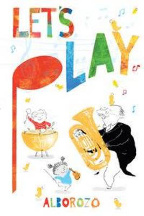Let's Play by Gabriel Alborozo

Allen & Unwin, 2014. ISBN 9781743316283.
(Age: Early childhood) It's been a strange week - one of those ones
where something you rarely think about keeps popping up in front of
you. No one on this planet could ever describe me as musical - when
that talent was given out I was definitely behind the door - but for
the third time in three days there has been something significant
about music that has caught my attention. Firstly, this poster
from The Orlando Philharmonic Orchestra about the importance of
music in a child's life came through my FB feed and I had to share
it with my teaching colleagues, all of whom are talented enough to
act on it. Photo:
The importance of music education! Then there was a news
report about research about the effect of music on literacy
learning and the review book on top of my pile is called Let's
Play and is a delightful introduction to the instruments of
the orchestra by Gabriel Alborozo. I'm certain the elves were in my
office last night and moved it up because clearly it was meant to be
the next one!
In Let's Play a group of very young children are introduced
to the orchestra by a man who looks like the epitome of a stern
conductor but who actually is much gentler than that as he isn't
bothered by the children moving and clinging to him as he takes them
on a journey through the percussion section, the brass, strings and
woodwind, and, finally, the piano and harp. His love and passion is
clear and the children are just as fascinated as each gets to try
one of the instruments. However, this is not a dry, factual,
encyclopaedic explanation. As they go to each section, there's a
comment to each musician that adds an element of humour and
individuality and the superb illustrations which tell the real story
and lift it into the realm of the special and unique. While the
conductor and the children are line drawings, the instrument is in
colour and each page has the sound it makes interpreted in shape and
colour, until the whole becomes joined in a celebration of both
colour and sound which is 'Magnifico!' There are so many reasons
this book should be in your collection - it's the perfect textual
extension to Tchaikovsky's Peter and the Wolf as well as the many
online sites which enable students to hear the sounds as they see
the instruments. (My favourite has always been Energy
in the Air: Sounds of the Orchestra created by two young boys
for the Thinkquest Jr project but there are many others.) It is also
the perfect stimulus to having the students interpret the sounds of
the instruments and musical pieces into their own art pieces, which
might then lead on to their thinking about the sorts of instruments
or compositions which might accompany pieces of literature.
While it's clear the target audience for the text is early
childhood, in the hands of an imaginative teacher it could be used
throughout the school. A treasure indeed.
Barbara Braxton